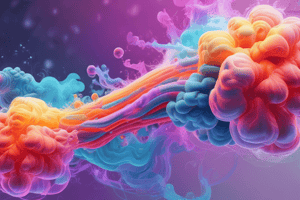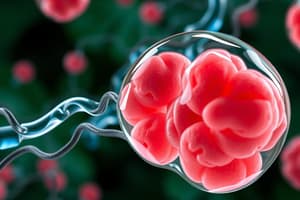Podcast
Questions and Answers
How does the partial pressure of oxygen (PO2) affect hemoglobin's affinity for oxygen?
How does the partial pressure of oxygen (PO2) affect hemoglobin's affinity for oxygen?
- High PO2 decreases hemoglobin's affinity for oxygen
- PO2 has no effect on hemoglobin's affinity for oxygen
- High PO2 increases hemoglobin's affinity for oxygen (correct)
- Low PO2 increases hemoglobin's affinity for oxygen
What primarily increases the diffusing capacity for oxygen during exercise?
What primarily increases the diffusing capacity for oxygen during exercise?
- Increased blood viscosity
- Increased oxygen solubility in blood
- Decreased pulmonary capillary pressure
- Increased surface area of capillaries (correct)
What is the composition of adult hemoglobin regarding its polypeptide chains?
What is the composition of adult hemoglobin regarding its polypeptide chains?
- 4 beta chains
- 2 alpha chains and 2 beta chains (correct)
- 4 alpha chains
- 3 alpha chains and 1 beta chain
In what form is oxygen predominantly transported in the blood?
In what form is oxygen predominantly transported in the blood?
Which statement best describes what occurs when oxygen is released from hemoglobin in tissues?
Which statement best describes what occurs when oxygen is released from hemoglobin in tissues?
What happens to the oxygen saturation of blood as it passes through the pulmonary capillaries?
What happens to the oxygen saturation of blood as it passes through the pulmonary capillaries?
What physiological change occurs to the oxygen-hemoglobin dissociation curve during exercise?
What physiological change occurs to the oxygen-hemoglobin dissociation curve during exercise?
What factor is NOT associated with effective pulmonary gas exchange?
What factor is NOT associated with effective pulmonary gas exchange?
What is the PCO2 in the interstitial fluid surrounding tissue cells?
What is the PCO2 in the interstitial fluid surrounding tissue cells?
How does a decrease in blood flow to peripheral tissues affect the PCO2 levels in those tissues?
How does a decrease in blood flow to peripheral tissues affect the PCO2 levels in those tissues?
What is the approximate PCO2 of arterial blood that is entering tissue?
What is the approximate PCO2 of arterial blood that is entering tissue?
Which factor primarily drives the diffusion of CO2 from the pulmonary capillaries into the alveoli?
Which factor primarily drives the diffusion of CO2 from the pulmonary capillaries into the alveoli?
What happens to interstitial PCO2 when blood flow to peripheral tissues is increased sixfold?
What happens to interstitial PCO2 when blood flow to peripheral tissues is increased sixfold?
What is the intracellular PCO2 in tissue cells?
What is the intracellular PCO2 in tissue cells?
How does the PCO2 of venous blood leaving the tissue compare to arterial blood entering it?
How does the PCO2 of venous blood leaving the tissue compare to arterial blood entering it?
In the context of pulmonary gas exchange, what is the approximate PCO2 of alveolar air?
In the context of pulmonary gas exchange, what is the approximate PCO2 of alveolar air?
What is the primary effect of diffusion on blood PCO2?
What is the primary effect of diffusion on blood PCO2?
What role does fetal hemoglobin play compared to adult hemoglobin regarding oxygen affinity?
What role does fetal hemoglobin play compared to adult hemoglobin regarding oxygen affinity?
How does increased BPG in prolonged hypoxic conditions affect the oxygen-hemoglobin dissociation curve?
How does increased BPG in prolonged hypoxic conditions affect the oxygen-hemoglobin dissociation curve?
What is the relationship between CO2 diffusion rates and O2 diffusion rates?
What is the relationship between CO2 diffusion rates and O2 diffusion rates?
What does an increased hydrogen ion concentration indicate about oxygen delivery to tissues?
What does an increased hydrogen ion concentration indicate about oxygen delivery to tissues?
During what distance into the capillaries does diffusion occur efficiently?
During what distance into the capillaries does diffusion occur efficiently?
Which of the following is true about CO2 transport from tissues?
Which of the following is true about CO2 transport from tissues?
What is the result of oxygen being used by cells in terms of PCO2?
What is the result of oxygen being used by cells in terms of PCO2?
Flashcards are hidden until you start studying
Study Notes
Diffusion and Oxygen Transport
- Diffusion in the lungs lowers blood carbon dioxide (CO2) levels and reduces hydrogen ion concentration.
- This shifts the oxygen-hemoglobin dissociation curve to the left and upward.
- As a result, more oxygen binds to hemoglobin at any given alveolar oxygen partial pressure (PO2).
- This facilitates greater oxygen transport to tissues.
- Fetal hemoglobin binds to oxygen with higher affinity than adult hemoglobin.
Carbon Dioxide Transport
- CO2 diffuses from tissues into capillaries and eventually to the lungs.
- This process is about 20 times faster than oxygen diffusion.
- During exercise, the diffusing capacity for oxygen increases almost threefold mainly due to increased capillary surface area and a more ideal ventilation-perfusion ratio.
Oxygen Transport in Blood
- Oxygen is transported in blood in two forms:
- Dissolved in solution
- Bound to hemoglobin (most common form)
- Hemoglobin is a globular protein with four subunits, each containing a heme moiety which is an iron-containing porphyrin.
- The iron is in the ferrous state (Fe2+) and binds to O2.
- Each subunit has a polypeptide chain:
- 2 alpha chains
- 2 beta chains
Oxygen-Hemoglobin Dissociation Curve
- The curve shifts to the left when oxygen affinity increases (higher affinity for hemoglobin).
- The curve shifts to the right when oxygen affinity decreases (lower affinity for hemoglobin).
Effect of Bisphosphoglycerate (BPG) on Oxygen-Hemoglobin Dissociation Curve
- Normal BPG levels in blood slightly shift the oxygen-hemoglobin dissociation curve to the right.
- During hypoxia, BPG levels increase, causing a further rightward shift.
- This shift facilitates the release of O2 to tissues in conditions of lower oxygen availability.
Carbon Dioxide Transport: Diffusion and Pressure
- The pressures of CO2 in the tissue, interstitial fluid, and blood are:
- Intracellular PCO2 = 46 mm Hg
- Interstitial PCO2 = 45 mm Hg
- Arterial Blood PCO2 = 40 mm Hg
- Venous Blood PCO2 = 45 mm Hg
- There is a pressure difference of 5 mm Hg which drives CO2 diffusion from the pulmonary capillaries into the alveoli.
Influence of Blood Flow and Tissue Metabolism on Tissue Carbon Dioxide Pressure (PCO2)
- Decreased blood flow leads to decreased blood flow and tissue PCO2 rises.
- Increased blood flow leads to higher PCO2.
- Tissue PCO2 is influenced by metabolic rate and blood flow.
Studying That Suits You
Use AI to generate personalized quizzes and flashcards to suit your learning preferences.





